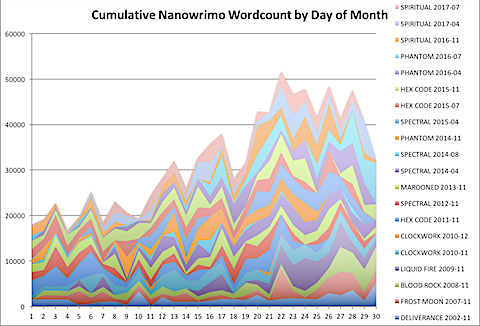
Above you see a big pile of all the words I’ve written in National Novel Writing Month and related challenges, laid out horizontally by day of month and laid down vertically by the challenge in which I wrote them, creating an interesting strata effect, like words deposited by a geological process. This month marks my 20th attempt at Nano, 18 of which were successful:
Deliverance 2002 Nanowrimo WINNER Frost Moon 2007 Nanowrimo WINNER Blood Rock 2008 Nanowrimo WINNER Liquid Fire 2009 Nanowrimo WINNER Clockwork 2010 Nanowrimo WINNER Clockwork 2010 December Nano FAILED Hex Code 2011 Nanowrimo WINNER Clockwork 2012 Script Frenzy WINNER Spectral Iron 2012 Nanowrimo WINNER Marooned 2013 Nanowrimo WINNER Spectral Iron 2014 Camp Nanowrimo WINNER Spectral Iron 2014 August Nano FAILED Phantom Silver 2014 Nanowrimo WINNER Spectral Iron 2015 Camp Nanowrimo WINNER Hex Code 2015 Nanowrimo WINNER Phantom Silver 2016 Camp Nanowrimo WINNER Phantom Silver 2016 Camp Nanowrimo WINNER Spiritual Gold 2016 Nanowrimo WINNER Spiritual Gold 2017 Camp Nanowrimo WINNER Spiritual Gold 2017 Camp Nanowrimo WINNER
As I’ve noted before, the two in which I failed were “off months” where I tried to tackle Nanowrimo on my own. For me, it’s much harder without the external benefit of the contest, and on the two times I tried it I bombed out after a few days. You can see that in this graph, which shows the number of words I’m ahead or behind at each part of the month:
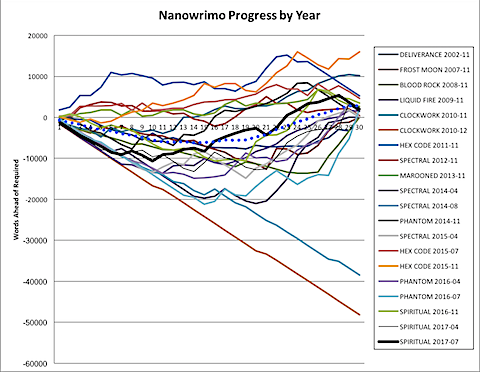
This graph means the most to me, because I was involved in the creation of it, and so intuitively understand it; if I see my monthly progress (the darkest line above) below the dotted line of the average, I know to worry; if I see it below my worst track for any part of the month, I know to really get cracking. Looks like the farthest behind I ever got (and succeeded) was 20,00 words behind, on LIQUID FIRE in 2009, and in PHANTOM SILVER in 2016.
But for people not intimately involved in laying down those tracks, the average amount ahead / behind per day is perhaps more useful:
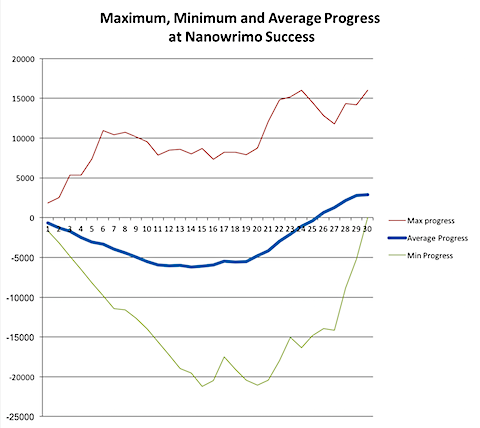
This shows that a successful Nanowrimo participant can be very far ahead, or very far behind, and still win in the month. Do what works for you! There’s a lot of wiggle room in there.
But if you’re more interested in brass tacks, here’s the maximum and average amount I wrote in each day:
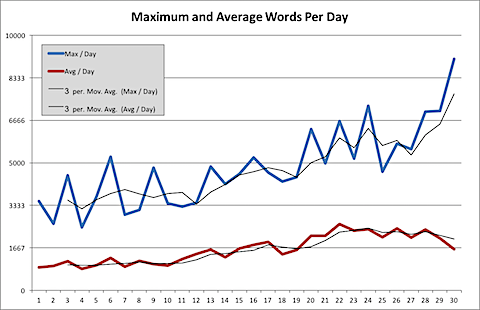
This shows that typically at the start of Nano I’m writing a little bit less than the needed word count per day, and at the end of Nano I’m writing a little bit more – but that the maximum I have to do each day is radically more than that – once almost 10,000 words (and that was a hell of a push, I can tell you – that was PHANTOM SILVER in July of 2016, and I was down to the wire, writing 7000 words in the last day – and finding the Camp Nano counter was 2000 words off of Microsoft Word’s count, so I had to generate 2,000 more words in the last couple of hours).
I will probably dig a bit more into SPIRITUAL over the last two days of the 30 day challenge (I know July has an extra day, but I can use the break). I’m not quite done – the manuscript is at 171,330 words, but maybe 20,000 to 30,000 words of that are in-manuscript notes that need to be turned into text, and then I have a lot I want to cut. During Nano, if I change my mind about how a scene is going, I don’t cut it and rewrite it, because that defeats the purpose of generating words; I write the word ALTERNATELY on its own line and rewrite the scene. After Nano, all that needs to get edited, merged and/or cut.
Often, I find that I’m not satisfied with the first rough draft text I produce in Nano. There are amazing gems in there, but also drek. But at the same time, I find that I am almost always very satisfied at having a text that flows through all the scenes I wanted to write. The idea of a scene in your head is just that – an idea. It’s not real until you write it. If you don’t write it, you can’t improve it – you’ll either long for it to be written, or you’ll elaborate on your idea of it in your head endlessly, or, worst of all, get caught up in the smug satisfaction of your own unfinished work, admiring the creation of something awesome that doesn’t actually exist.
But once you write it, you can see whether the idea works or not. You can decide to keep it, or refine it, or discard it. Even better, it springboards you – into new alternates for the same scene, or new ideas for what happens next, or new insights into your character, their plot, and the themes of your story.
Don’t just dream your story – write it down. Only by writing dreams down can you turn them into reality.
And Nanowrimo is a great place to get started with that. The 50,000 word challenge may seem impossible. It may not even seem like the kind of thing you want to do. No one is making you, after all: you don’t have to. But if your head is filling with ideas and you can’t get them out, why not take on an impossible seeming challenge to write 50,000 words of them down.
Believe me, it’s possible.
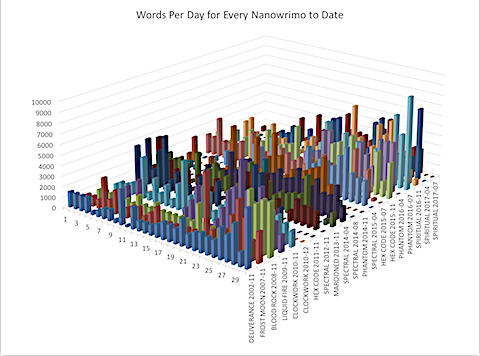
-the Centaur